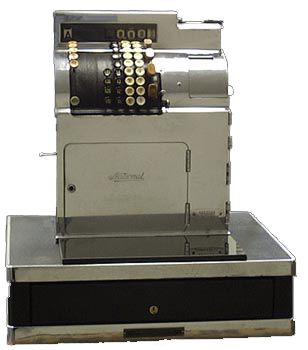If you’ve ever harbored doubts about the reliability of touch-screen voting machines, then Clive Thompson’s article in this Sunday’s New York Times Magazine will turn those doubts into certainty. Thompson spends thousands of words lambasting the touch-screen machines, their makers, and the local elections boards that purchased them. Near the end, Thompson puts forth an alternative system that has proven far more reliable in the past than touch-screen machines: optical scan ballots. In the interest of postulating diverse solutions to an important problem, I offer this:

BAM!
This is the National Cash Register Corporation’s Class 1900 cash register. It is the single most reliable machine I have ever used, with the possible exception of a pair of nail clippers I’ve owned for about twenty years. I was in the bar business for five years, and every place I worked had at least two of these on the back bar. I’ve also been to countless of establishments that eschew newer registers and choose to instead employ the 1900. This is truly remarkable, considering NCR stopped making or producing replacement parts for the 1900 decades ago. What a warhorse.
This machine performs the essentials of registering sales all-but flawlessly. It records every transaction singly, and produces added totals on demand. In addition, every button function creates a verifiable written record, an absolute must when counting out the money from the drawer at the end of a shift. There were nights I worked when more than ten thousand dollars were shoved into one of these machines in an eight-hour shift, and there was rarely a discrepancy between the hand-counted and machine totals of more than twenty or thirty bucks. I can only attribute those small amounts to human error. But think about that for a second. On the busiest, most frantic nights behind the bar, two, sometimes three bartenders running back and forth and ringing transactions as fast as they could move their fingers, there was rarely a margin of error with these machines greater than three-tenths of a percentage point. And like I said, the reliable mechanics of these things lead me to believe the errors came from the people punching the buttons and actually handling the cash, not the machines.
With this type of reliable technology available, and a demand for voting techniques that can produce totals quickly, why aren’t there more electrically-powered, motor-driven machines out there? I think the main issue is age. There is nothing new or glitzy about dials and gears, no matter how reliable they are. We are a culture enamored by new solutions to problems we’ve already solved, all in an endless search for greater efficiency, and more dollars for the peddlers of those new solutions. Computer-based voting systems promise to bring democracy into the 21st century, a laudable goal, but anyone who toils in the world of programming (like myself) knows, computers can throw some crazy curveballs at users that programmers fail to anticipate. On top of that, personal experience has also taught me that sometimes computers just do weird shit. Their processors and circuits are practical manifestations of very impractical physics, some of it bizarre. On more than one occasion, I’ve been forced to explain a computer’s erratic behavior by employing the Heisenberg Uncertainty Principle. I won’t bore you with the details, but think about it like this: Imagine the expectations of a user dictating what they are seeing on the computer’s monitor, instead of the actual contents of an opened file showing up on the screen. Swear, I’ve seen it happen more than once.
So computers, to this point, are too unreliable to be used for tallying votes. Maybe we should just switch to the optical scans mentioned earlier that have proven reliable. That is one answer, but optical scanning is not the only system out there that has proven its worth. New York and Connecticut have been using mechanical lever machines to record votes for decades. One advantage of the lever machines is their ability to register vote totals quickly, which is one of the reasons some states have tried to move away from paper balloting, only to embrace faulty technology. But the lever machines aren’t perfect. The main criticism of them is that the geniuses that designed them left out one function that makes the 1900 cash register so valuable. All votes are recorded internally on counter wheels only. There is no spool of paper that records every vote as a redundant backup. It’s a baffling omission, and one that has led to the reliability of the lever machines being questioned. However, unlike touch-screen machines, the principles behind a mechanically-based voting system like the lever machines have been proven by their long service record, and by the reliability of machines like the NCR 1900. An amalgamation of those two systems, the easy-to-use faceplate of the lever machines, combined with the steadfast mechanics of the NCR 1900, with it’s capacity to record every vote on paper singly and in toto, would do much to increase confidence in a participatory democracy whose validity seems increasingly fragile.
